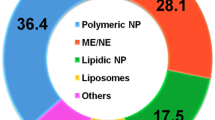Abstract
Nanosuspension administration via the nasal route of administration appears to be an effective pathway of nose-to-brain drug delivery. The nasal cavity is highly vascularized and innervated by nerves, making it an attractive route of administration that bypasses many oral or parenteral limitations and challenges, thus having more advantages and being an effective treatment choice, especially for neuronal diseases. Nanosuspension was found to be an enhancer of drug absorption though the nasal route of administration due to its small particle size and its capability of optimizing the hydrophilic drugs within it to increase its solubility. Intranasal nanosuspensions are currently being investigated to improve nose-to-brain drug delivery. Nose-to-brain drug delivery and nanosuspension application (insight for nose-to-brain drug delivery) are discussed in this chapter.
Access this chapter
Tax calculation will be finalised at checkout
Purchases are for personal use only
Similar content being viewed by others
References
Lee D, Minko T. Nanotherapeutics for nose-to-brain drug delivery: an approach to bypass the blood brain barrier. Pharmaceutics [Internet]. 2021 [cited 10 November 2021];13(12):2049. Available from: https://doi.org/10.3390/pharmaceutics13122049.
Agrawal Y, Patel V. Nanosuspension: an approach to enhance solubility of drugs. J Adv Pharm Technol Res. 2011;2(2):81.
Verma S, Gokhale R, Burgess D. A comparative study of top-down and bottom-up approaches for the preparation of micro/nanosuspensions. Int J Pharm. 2009;380(1–2):216–22.
Verma S, Lan Y, Gokhale R, Burgess D. Quality by design approach to understand the process of nanosuspension preparation. Int J Pharm [Internet]. 2009 [cited 5 December 2021];377(1–2):185–98. Available from: https://doi.org/10.1016/j.ijpharm.2009.05.006.
Erdő F, Bors L, Farkas D, Bajza Á, Gizurarson S. Evaluation of intranasal delivery route of drug administration for brain targeting. Brain Res Bull [Internet]. 2018 [cited 7 December 2021];143:155–70. Available from: https://doi.org/10.1016/j.brainresbull.2018.10.009.
Cassano R, Servidio C, Trombino S. Biomaterials for drugs nose–brain transport: a new therapeutic approach for neurological diseases. Materials [Internet]. 2021 [cited 10 December 2021];14(7):1802. Available from: https://doi.org/10.3390/ma14071802.
Veronesi M. Imaging of intranasal drug delivery to the brain. Am J Nucl Med Mol Imaging. 2020 [PubMed] [cited 4 December 2021];10(1):1–31. Available from: https://www.ncbi.nlm.nih.gov/pmc/articles/PMC7076302/.
Crowe TP, Greenlee MHW, Kanthasamy AG, Hsu WH. Mechanism of intranasal drug delivery directly to the brain. Life Sci. 2018;195:44–52. https://doi.org/10.1016/j.lfs.2017.12.025.
Hasnain S, Nayak A. Natural polysaccharides in drug delivery and biomedical applications. San Diego: Elsevier Inc.; 2019. p. 2–152.
Bhatia S. Natural polymer drug delivery systems; nanoparticles, plants, and algae. Springer International Publishing Switzerland; 2016. p. 95–118. https://doi.org/10.1007/978-3-319-41129-3.
Sahoo R, Sahoo S, Azizi S. Tamarind seed polysaccharides and their nanocomposites for drug delivery: an economical, eco-friendly and novel approach. MJMS. 2017;2(2):32–40.
Shao H, Zhang H, Tian Y, Song Z, Lai PFH, Ai L. Composition and rheological properties of polysaccharide extracted from tamarind (Tamarindus indica L.) seed. Molecules. 2019;24(7):1218. https://doi.org/10.3390/molecules24071218.
Goel S, Sachdeva M, Agarwal V. Nanosuspension technology: recent patents on drug delivery and their characterizations. Recent Pat Drug Deliv Formul. 2019;13(2):91–104.
Piacentini E. Encapsulation efficiency. In: Encyclopedia of membranes; 2016; pp. 706–7.
Database.ich.org. 2021. [online] Available at: https://database.ich.org/sites/default/files/Q1A%28R2%29%20Guideline.pdf. Accessed 12 Feb 2021.
Westin U, Piras E, Jansson B, Bergström U, Dahlin M, Brittebo E, Björk E. Transfer of morphine along the olfactory pathway to the central nervous system after nasal administration to rodents. Eur J Pharm Sci. 2005;24:565–73. https://doi.org/10.1016/j.ejps.2005.01.009.
Gonçalves VSS, Matias AA, Poejo J, Serra AT, Duarte CMM. Application of RPMI 2650 as a cell model to evaluate solid formulations for intranasal delivery of drugs. Int J Pharm. 2016;515:1–10. https://doi.org/10.1016/j.ijpharm.2016.09.086.
Qian S, He L, Wang Q, Wong YC, Mak M, Ho CY, Han Y, Zuo Z. Intranasal delivery of a novel acetylcholinesterase inhibitor HLS-3 for treatment of Alzheimer’s disease. Life Sci. 2018;207:428–35. https://doi.org/10.1016/j.lfs.2018.06.032.
Dolberg AM, Reichl S. Expression of P-glycoprotein in excised human nasal mucosa and optimized models of RPMI 2650 cells. Int J Pharm. 2016;508:22–33. https://doi.org/10.1016/j.ijpharm.2016.05.010.
Cho HJ, Termsarasab U, Kim JS. In vitro nasal cell culture systems for drug transport studies. J Pharm Investig. 2010;40:321–32. https://doi.org/10.4333/kps.2010.40.6.321.
Selvaraj K, Gowthamarajan K, Karri VVSR. Nose to brain transport pathways an overview: potential of nanostructured lipid carriers in nose to brain targeting. Artif Cells Nanomed Biotechnol. 2018;46(8):2088–95. https://doi.org/10.1080/21691401.2017.1420073.
Eskandari S, Varshosaz J, Minaiyan M, et al. Brain delivery of valproic acid via intranasal administration of nanostructured lipid carriers: in vivo pharmacodynamic studies using rat electroshock model. Int J Nanomedicine. 2011;6:363–71.
Alam MI, Baboota S, Ahuja A, Ali M, et al. Intranasal infusion of nanostructured lipid carriers (NLCS) containing CNS acting drug and estimation in brain and blood. Drug Deliv. 2013;20:247–51.
Jain K, Sood S, Gowthamarajan K. Optimization of artemether loaded NLCS for intranasal delivery using central composite design. Drug Deliv. 2015;22:940–54.
Khan A, Imam SS, Aqil M, et al. Brain targeting of temozolomide via the intranasal route using lipid-based nanoparticles: brain pharmacokinetic and scintigraphic analyses. Mol Pharm. 2016;13:3773–82.
Singh SK, Dadhania P, Vuddanda PR, et al. Intranasal delivery of asenapine loaded nanostructured lipid carriers: formulation, characterization, pharmacokinetic and behavioural assessment. RSC Adv. 2016;6:2032–45.
Ross TM. Intranasal administration of interferon beta bypasses the blood–brain barrier to target the central nervous system and cervical lymph nodes: a non-invasive treatment strategy for multiple sclerosis. J Neuroimmunol. 2004;151(1–2):66–77. https://doi.org/10.1016/j.jneuroim.2004.02.011.
Ahmed M, Khan U, Haye A, Agarwal N, Alhakamy N, Alhadrami H, et al. Liquid crystalline nanoparticles for nasal delivery of rosuvastatin: implications on therapeutic efficacy in management of epilepsy. Pharmaceuticals. 2020;13(11):356.
EU Clinical Trials Register - Update [Internet]. Clinicaltrialsregistereu. 2022 [cited 9 January 2022]. Available from: https://www.clinicaltrialsregister.eu/.
Evaluation of ivermectin mucoadhesive nanosuspension as nasal spray in management of early covid-19 - Full Text View - ClinicalTrials.gov [Internet]. Clinicaltrials.gov. 2022 [cited 9 January 2022]. Available from: https://clinicaltrials.gov/ct2/show/nct04716569.
Author information
Authors and Affiliations
Editor information
Editors and Affiliations
Rights and permissions
Copyright information
© 2023 The Author(s), under exclusive license to Springer Nature Switzerland AG
About this chapter
Cite this chapter
Yadav, H.K.S., Alabdin, R.Z. (2023). Nanosuspension – A Novel Drug Delivery System via Nose-to-Brain Drug Delivery. In: Pathak, Y.V., Yadav, H.K.S. (eds) Nasal Drug Delivery. Springer, Cham. https://doi.org/10.1007/978-3-031-23112-4_15
Download citation
DOI: https://doi.org/10.1007/978-3-031-23112-4_15
Published:
Publisher Name: Springer, Cham
Print ISBN: 978-3-031-23111-7
Online ISBN: 978-3-031-23112-4
eBook Packages: Biomedical and Life SciencesBiomedical and Life Sciences (R0)




